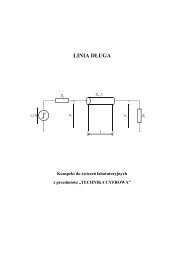9 Interlayer Exchange Interactions in Magnetic Multilayers
9 Interlayer Exchange Interactions in Magnetic Multilayers
9 Interlayer Exchange Interactions in Magnetic Multilayers
You also want an ePaper? Increase the reach of your titles
YUMPU automatically turns print PDFs into web optimized ePapers that Google loves.
340 9 <strong>Interlayer</strong> <strong>Exchange</strong> <strong>Interactions</strong> <strong>in</strong> <strong>Magnetic</strong> <strong>Multilayers</strong><br />
In this case the electron conf<strong>in</strong>ement <strong>in</strong> the overlayer gives rise to a sp<strong>in</strong>-dependent<br />
modulation of the spectral density as the overlayer thickness is changed; the period<br />
of the modulation is the same for both sp<strong>in</strong>s, whereas the amplitude and phase are<br />
expected to be sp<strong>in</strong>-dependent.<br />
The quantum size effects <strong>in</strong> paramagnetic overlayers on a ferromagnetic substrate<br />
have been <strong>in</strong>vestigated by several groups [85–98]. The systems studied most are Cu<br />
overlayers on a Co(001) substrate and Ag overlayers on a Fe(001) substrate. Ortega<br />
and Himpsel [86, 87] observed a quantum size effect <strong>in</strong> the normal-emission photoelectron<br />
spectra of a copper overlayer on a fcc cobalt (001) substrate. They observed<br />
peaks aris<strong>in</strong>g as a result of quantum size effects, and an oscillation of the photoemission<br />
<strong>in</strong>tensity <strong>in</strong> both, the photoemission and <strong>in</strong> the <strong>in</strong>verse photoemission spectra.<br />
These quantum size effects manifest themselves also <strong>in</strong> the form of oscillatory behavior<br />
<strong>in</strong> the photoemission <strong>in</strong>tensity at the Fermi level; because the observed oscillation<br />
period (5.9 atomic layers) is close to the long period of <strong>in</strong>terlayer exchange coupl<strong>in</strong>g<br />
oscillations <strong>in</strong> Co/Cu(001)/Co, it was suggested that the two phenomena should be<br />
related to each other: Ortega and Himpsel also claimed that the observed oscillations<br />
<strong>in</strong> photoemission are sp<strong>in</strong>-dependent and mostly arise from m<strong>in</strong>ority electrons. This<br />
conjecture has been confirmed directly, by Garrison et al. [89] and by Carbone et<br />
al. [90], <strong>in</strong>dependently, by means of sp<strong>in</strong>-polarized photoemission. They found that<br />
both the <strong>in</strong>tensity and the sp<strong>in</strong>-polarization have oscillatory behavior with the same<br />
period (5–6 atomic layers) but opposite phases; this <strong>in</strong>dicates that the quantum-size<br />
effect does <strong>in</strong>deed take place predom<strong>in</strong>antly <strong>in</strong> the m<strong>in</strong>ority-sp<strong>in</strong> band, as proposed<br />
by Ortega and Himpsel [86, 87]. Kläsges et al. [96] and Kawakami et al. [98] have recently<br />
observed sp<strong>in</strong>-polarized quantum-size effects <strong>in</strong> a copper overlayer on cobalt<br />
(001) for a non-zero, <strong>in</strong>-plane wavevector correspond<strong>in</strong>g to the short period oscillation<br />
of <strong>in</strong>terlayer exchange coupl<strong>in</strong>g <strong>in</strong> Co/Cu(001)/Co; they observed short-period<br />
oscillations of the photoemission <strong>in</strong>tensity, <strong>in</strong> good agrement with the short-period<br />
oscillations of <strong>in</strong>terlayer coupl<strong>in</strong>g. This observation provides a further confirmation<br />
of the relationship between quantum-size effects <strong>in</strong> photoemission and oscillation<br />
of <strong>in</strong>terlayer exchange coupl<strong>in</strong>g.<br />
Photoemission studies of quantum size effects have also been performed on other<br />
types of system, e. g. a ferromagnetic overlayer on a non-magnetic substrate, or<br />
systems compris<strong>in</strong>g more layers [99–103].<br />
Photoemission spectroscopy undoubtedly constitutes a method of choice for <strong>in</strong>vestigat<strong>in</strong>g<br />
quantum-size effects <strong>in</strong> metallic overlayers; this is because its unique<br />
features enable selectivity <strong>in</strong> energy, <strong>in</strong>-plane wavevector, and sp<strong>in</strong>.<br />
Besides photemission, sp<strong>in</strong>-polarized quantum-size effects <strong>in</strong> paramagnetic overlayers<br />
on a ferromagnetic substrate also cause oscillatory behavior (which depends<br />
on overlayer thickness) of sp<strong>in</strong>-polarized secondary electron emission [104, 105], l<strong>in</strong>ear<br />
[106–111], and non-l<strong>in</strong>ear [112, 113] magneto-optical Kerr effect, and magnetic<br />
anisotropy [114, 115]. These effects usually, however, <strong>in</strong>volve a summation over all<br />
electronic states, and so quantitative analysis of these quantum-size effects may be<br />
fairly complicated.



